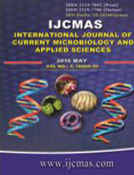


 National Academy of Agricultural Sciences (NAAS)
National Academy of Agricultural Sciences (NAAS)

|
PRINT ISSN : 2319-7692
Online ISSN : 2319-7706 Issues : 12 per year Publisher : Excellent Publishers Email : editorijcmas@gmail.com / submit@ijcmas.com Editor-in-chief: Dr.M.Prakash Index Copernicus ICV 2018: 95.39 NAAS RATING 2020: 5.38 |
For the last few decades, fossil fuels played most dominant role as an important energy resource in the enormous energy demanding scenario throughout the world. However, as conventional fossil fuel resources are limited, excessive exploitation of such fossil fuel comes up with major global problem of energy resource scarcity. In such scenario, alternative and renewable sources of energy such as solar, wind, biofuel gained huge attention from governments of many countries across the world. Among these alternate energy sources, bio-ethanol was proved to be a most promising energy source with various added advantages. Conventional indigenous raw material for bio-ethanol production includes sugarcane, molasses and corn based materials which became highly popular for bio-ethanol production although amount of produced bio-ethanol can hardly meet the current global demand for biofuel. Extensive search for most promising feed stock for ethanol production pioneered the use of lignocellulosic biomasses and starch based materials. For successful conversion of starch and lignocellulosic material to bio-ethanol, microbial single stage simultaneous saccharification and fermentation (SSF) approach has been successfully evolved in recent years with outstanding potential to meet global need bio-ethanol.
 |
 |
 |
 |
 |